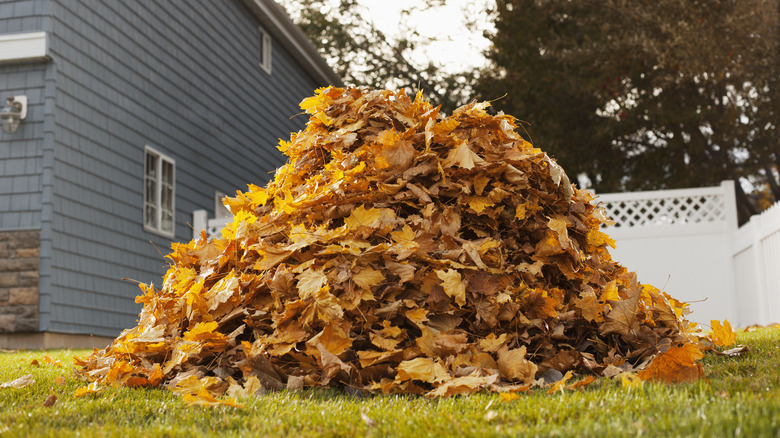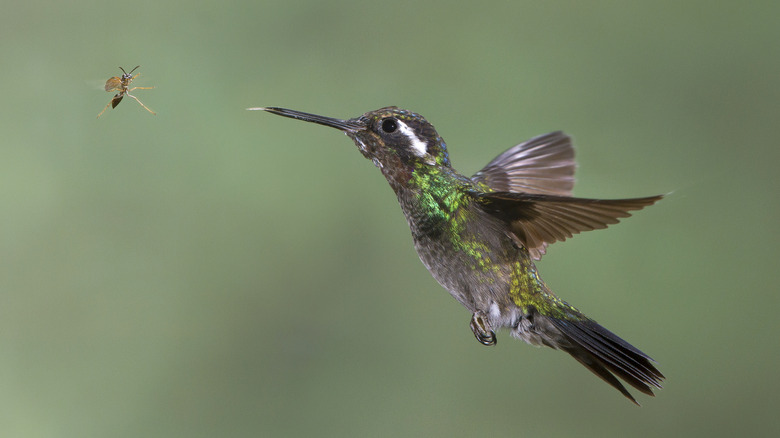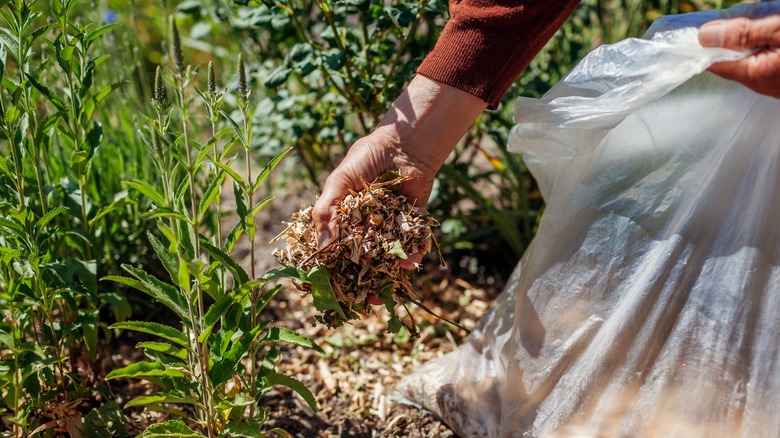Why You Should Keep A Pile Of Leaves In Your Yard To Attract Hummingbirds
If you've been looking for ways to attract more hummingbirds to your garden, you've probably seen a lot of tips about adding a nectar feeder or planting nectar-rich plants. These tips and tricks work, but there's an even easier trick that doesn't require spending a dime or doing any work whatsoever. The trick: leave the leaves.
When your trees start to shed their leaves in fall, don't bag them up. Just leave them. It's prime habitat for lots of different insects who overwinter under the layers of leaves. Hummingbirds, in turn, can feast on those critters when they emerge from the leaves. While the adorable birds are better known for guzzling down nectar, about 80% of their diet is actually made up of insects and spiders. So leaving the leaves this fall ensures there will be a protein-rich buffet of bugs to snack on after the colorful birds visit your hummingbird feeder.
How leaving leaves helps feed hummingbirds
Since so much of a hummingbird's diet is made up of insects and spiders, gardeners should incorporate some bug-friendly practices into their routine. Simply opting to skip the tedious task of raking the dead leaves on your lawn is one of the easiest and most impactful ways to do that. If you prefer the aesthetics of a leaf-free lawn or the amount of leaf litter you get is thick enough to smother your grass, you might have no choice but to rake them. In that case, you can rake them into a pile in the back of your yard or repurpose them as mulch for your garden beds.
Over the winter, many species of insects will shelter under the leaves, feed on them as they decompose, and lay their eggs there. This is true for many of the most important bugs in a hummingbird's diet, including ants, gnats and beetles. It's also true for pollinators like bees and butterflies. So, in addition to providing food for hummingbirds and other insect-loving birds, leaving the leaves can also attract more pollinators to your garden.
A third perk of leaving the leaves is free compost. According to the University of California Division of Agriculture and Natural Resources, leaves contain somewhere between 50% and 80% of the nutrients a tree takes from the air during the growing season. As your leaf layer decays, it will release those nutrients into the soil to nourish your garden come spring.
Pest control when leaving the leaves
Keeping leaves can provide hummingbirds with lots of tasty bugs come spring. However, it's not just beneficial bugs that flock to leaf litter for the winter. The decaying leaves can also be a breeding ground for pests like mosquitoes and ticks. Fortunately, there are some strategies you can use to control the pests without harming the beneficial bugs in your leaf pile.
For mosquitoes, sprinkle bacillus thuringensis, or Bti, a microbial insecticide on top of the area and water it. The naturally occurring soil bacteria kills mosquito larvae (as well as fungus gnats and blackflies) but it is completely harmless to non-target species. This essentially creates a mosquito trap as the leaves attract breeding mosquitoes while the Bti kills their larvae after they lay their eggs.
For ticks, it's a little trickier because there isn't a species-specific pesticide that targets them without harming non-target species. So, your best options are to do it in a way that reduces the risk of tick exposure. First, avoiding creating deep piles of leaves. According to a 2020 study in the Journal of Medical Entomology, blacklegged tick populations are highest in leaf litter piles that were over 6 inches deep. So, using leaves as a mulch layer that's only 1 or 2 inches deep could help make the leaves less hospitable to ticks. You should also avoid keeping leaf piles in shaded areas, as ticks thrive in dark, moist environments.


